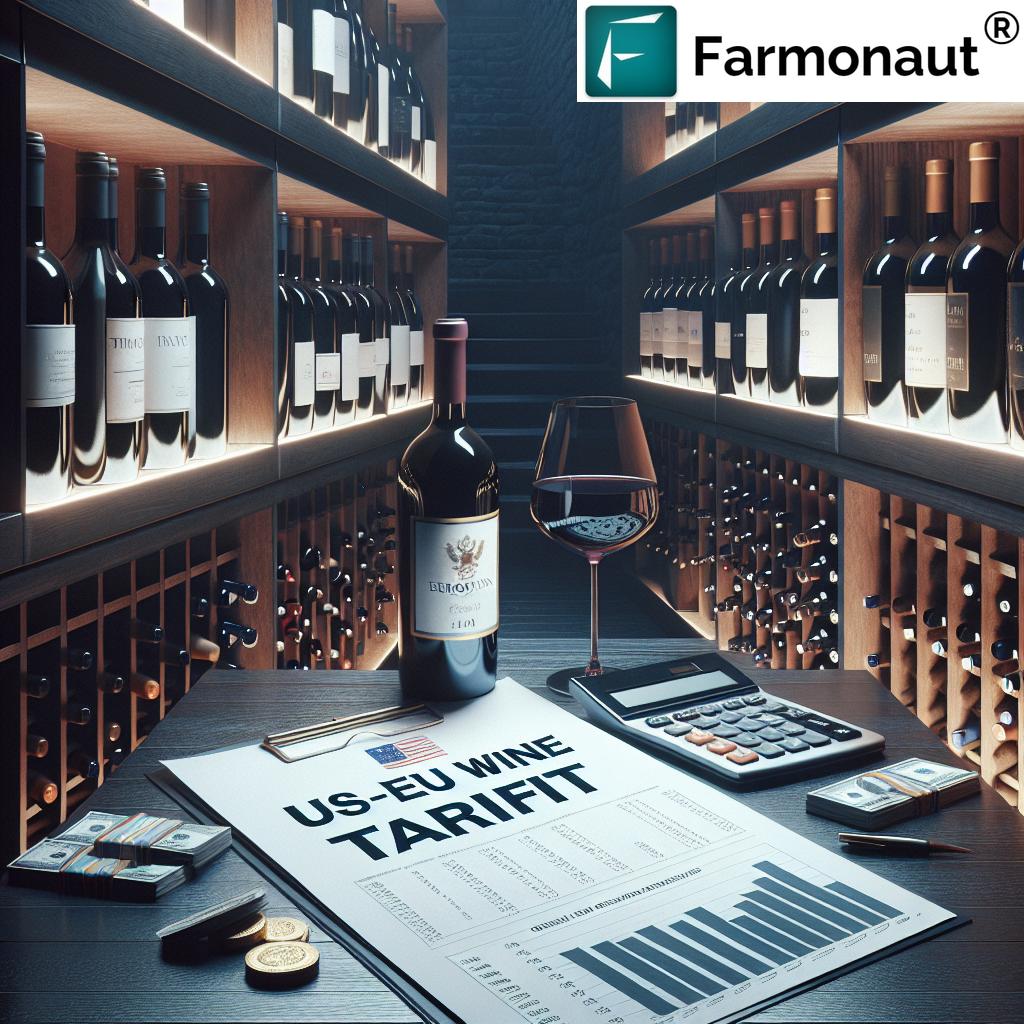US-EU Wine Tariff War: How European Wine Imports Could Transform American Industry
“The potential 200% tariff on European wines could drastically disrupt the $4.2 billion annual US-EU wine trade.”
In the world of international trade, few industries are as deeply intertwined and culturally significant as the wine industry. As we delve into the complex world of European wine tariffs and US wine import duties, we find ourselves at the precipice of a potential seismic shift in the global wine market. The looming threat of a 200% tariff on European wines, champagne, and spirits has sent shockwaves through the industry, prompting us to examine the far-reaching consequences of these trade tensions on both sides of the Atlantic.
In this comprehensive analysis, we’ll explore how these tariffs could reshape the landscape of wine distribution, affect wineries both in Europe and the United States, and ultimately impact the choices available to consumers. By understanding these industry trends, we aim to provide valuable insights for wine enthusiasts, professionals, and anyone interested in the intricate dance of international commerce.
The Current State of US-EU Wine Trade
Before we dive into the potential impacts of the proposed tariffs, let’s take a moment to understand the current state of the US-EU wine trade relationship. The United States and the European Union have long been significant partners in the wine industry, with a robust exchange of products that has shaped tastes and trends on both continents.
- In 2023, wines and spirits from the 27-nation European Union accounted for 17% of the total alcohol consumed in the US, according to IWSR, a global data and insight provider specializing in alcohol.
- Of that 17%, Italian products, primarily wine, made up 7%, while French wine, cognac, and vodka accounted for 5%.
- The US imported $26.6 billion worth of foreign-produced alcoholic beverages in 2022, accounting for 14% of all US agricultural imports.
- In contrast, the US exported $3.9 billion worth of beer, wine, and distilled spirits in the same year.
These figures underscore the significant imbalance in alcohol trade between the US and the EU, with the United States being a net importer of wine and spirits. This trade dynamic sets the stage for the potential disruption that could occur if the proposed tariffs are implemented.
The Looming Threat: A 200% Tariff on European Wines
The current trade tensions have their roots in a complex web of international disputes. The European Union has announced plans to impose a 50% tariff on American whiskey, set to take effect on April 1st. This move is a response to the previous US administration’s steel and aluminum tariffs. In retaliation, former President Donald Trump has threatened to impose a 200% tariff on all wines, champagnes, and alcoholic products coming from France and other EU countries.
The potential impact of such a drastic measure cannot be overstated. Industry experts and wine sellers are unanimous in their assessment: a 200% tariff would effectively shut down the European wine business in the United States.
“I don’t think customers are prepared to pay two to three times more for their favorite wine or Champagne,” says Ronnie Sanders, CEO of Vine Street Imports in Mt. Laurel Township, New Jersey.
This sentiment is echoed across the industry, with many professionals expressing concern about the far-reaching consequences of such a move.
Impact on US Wine Retailers and Importers
For US-based wine retailers and importers, the prospect of a 200% tariff on European wines presents a daunting challenge. Many businesses in the industry rely heavily on European imports to stock their shelves and satisfy customer demand.
- Jeff Zacharia, president of fine wine retailer Zachys in Port Chester, New York, reports that 80% of the wine he sells is from Europe.
- Importers depend on European wines for a significant portion of their distribution system.
- There are concerns that domestic US wine production is not sufficient to make up for the potential loss of European imports.
The uncertainty surrounding the tariff situation has already begun to affect business decisions. Zacharia mentions that he has stopped buying European wine until the situation becomes clearer, highlighting the immediate impact of trade tensions on day-to-day operations in the industry.
“It’s very hard to make preparations when as a business you don’t have a clear path forward,” Zacharia explains. “Our preparations would be very different if it’s 200% compared to 100% compared to 10%.”
This uncertainty is likely to ripple through the entire supply chain, affecting everything from inventory management to marketing strategies for wine retailers across the United States.
Potential Transformation of the US Wine Industry
While the immediate effects of such high tariffs on European wines would undoubtedly be disruptive, they could also lead to significant transformations within the US wine industry. Here are some potential outcomes:
- Boost for Domestic Wineries: With European wines becoming prohibitively expensive, US consumers might turn more towards domestic options. This could provide a significant boost to American wineries, potentially leading to increased investment and expansion in the sector.
- Rise of New Wine Regions: As the industry looks for alternatives to European imports, we might see increased interest in wines from other regions such as South America, Australia, and New Zealand. This could lead to a diversification of the US wine market and introduce consumers to new varieties and styles.
- Innovation in Winemaking: US winemakers might be incentivized to experiment with new techniques and grape varieties to replicate popular European styles. This could lead to innovation in the domestic wine industry and the development of unique American wine profiles.
- Shift in Consumer Preferences: Over time, the limited availability of European wines could reshape American palates, potentially leading to long-term changes in wine consumption patterns in the US.
While these potential outcomes present opportunities for growth and innovation in the US wine industry, it’s important to note that such a drastic shift would likely come with significant short-term disruptions and challenges for businesses and consumers alike.
European Perspective: A “Hammer Blow” to Exports
On the other side of the Atlantic, the reaction to the proposed tariffs has been one of grave concern. European wine producers and exporters view the potential 200% tariff as a devastating blow to their industry.
- Italian wine exports to the US have tripled in value over the last 20 years, reaching 1.9 billion euros ($2.1 billion) in 2023.
- For France, the US market for wines and spirits is worth 4 billion euros ($4.3 billion) annually.
Gabriel Picard, head of the French Federation of Exporters of Wines and Spirits, describes the potential tariffs as a “hammer blow” for France’s alcohol export industry, impacting hundreds of thousands of people.
“Not a single bottle will continue to be expedited if 200% tariffs are applied to our products. All exports to the United States will come to a total, total, halt,” Picard warns.
The impact is already being felt, with some winemakers cancelling planned shipments to the US in anticipation of potential tariffs. This freeze in exports could have long-lasting effects on European wine regions that have built their economies around wine production and export.
Lessons from History: The China-Australia Wine Dispute
To understand the potential long-term impacts of such high tariffs, we can look to a recent example in the global wine trade: the dispute between China and Australia. In 2020, China imposed tariffs as high as 218% on Australian wine, causing exports to plummet by 90%.
The effects of this trade action were profound:
- Australia’s wine trade to China, worth 1.1 billion Australian dollars ($710 million) annually before the tariffs, was effectively halted.
- The Australian wine industry suffered significant losses, with many producers forced to seek alternative markets or reduce production.
- Even after China lifted the tariffs in 2023, the Australian wine industry had already undergone significant restructuring and reorientation.
This case study serves as a stark reminder of how quickly high tariffs can reshape established trade relationships and the long-lasting impact they can have on exporting countries.
Consumer Impact: Higher Prices and Limited Choices
For wine enthusiasts and casual consumers alike, the implementation of a 200% tariff on European wines would have immediate and noticeable effects:
- Dramatic Price Increases: The cost of European wines, champagnes, and spirits would likely triple, putting many favorite labels out of reach for average consumers.
- Limited Availability: With imports potentially grinding to a halt, the variety of European wines available in US stores and restaurants would decrease significantly.
- Shift in Consumption Patterns: Consumers might be forced to explore domestic options or wines from non-EU countries, potentially changing long-standing preferences and habits.
These changes could lead to a significant transformation in the US wine culture, affecting everything from restaurant wine lists to home entertaining practices.
The Ripple Effect: Beyond Wine
While the focus of the tariff dispute is on wine and spirits, the potential impact extends far beyond just these products. The wine industry is deeply interconnected with various sectors of the economy, and disruptions in this trade could have wide-reaching effects:
- Tourism: Wine tourism, both in Europe and the US, could be affected as the availability and pricing of wines change.
- Hospitality Industry: Restaurants and hotels that rely on offering a diverse wine selection may need to revamp their offerings and pricing strategies.
- Agriculture: Changes in wine production and consumption patterns could impact grape growing and other related agricultural activities.
- Logistics and Distribution: Companies involved in the import, storage, and distribution of European wines may need to pivot their business models.
These interconnected effects underscore the complexity of international trade and the far-reaching consequences of trade disputes.
Looking Ahead: Potential Scenarios and Industry Adaptation
As the wine industry faces this potential upheaval, several scenarios could unfold:
- Negotiated Resolution: There’s a possibility that the US and EU could reach a compromise, avoiding the implementation of extreme tariffs. This would likely result in some adjustments to trade terms but avoid the most severe disruptions.
- Short-Term Implementation: If tariffs are implemented but only for a short period, we might see temporary market disruptions followed by a gradual return to previous patterns, albeit with some lasting changes.
- Long-Term Tariff Regime: In the case of prolonged high tariffs, we could witness a fundamental restructuring of the US wine market, with significant growth in domestic production and the emergence of new international trade partnerships.
Regardless of the outcome, the wine industry will need to demonstrate resilience and adaptability. This might involve:
- Diversifying sourcing strategies to reduce reliance on any single region
- Investing in technology and innovation to improve domestic wine production
- Developing new marketing strategies to educate consumers about alternative wine options
- Exploring new business models that can thrive in a changed market landscape
Conclusion: Navigating Uncertain Waters
The potential implementation of a 200% tariff on European wines represents a critical juncture for the global wine industry. While the immediate effects would likely be disruptive and challenging, they could also spark innovation and transformation within the US wine sector.
As we navigate these uncertain waters, it’s clear that adaptability will be key. Consumers, businesses, and policymakers alike will need to remain informed and flexible as the situation evolves. The wine industry, with its rich history and cultural significance, has weathered changes before, and it will undoubtedly find ways to adapt to this potential new reality.
Whether you’re a wine enthusiast, a industry professional, or simply an interested observer, staying informed about these developments will be crucial in understanding the changing landscape of the global wine market. As we raise our glasses to the future, one thing is certain: the world of wine is on the cusp of potentially transformative change.
FAQs
- Q: What is the current state of US-EU wine trade?
A: The EU accounts for 17% of alcohol consumed in the US, with Italy and France being major contributors. The US imported $26.6 billion worth of foreign alcoholic beverages in 2022. - Q: What is the proposed tariff on European wines?
A: A potential 200% tariff on European wines, champagnes, and spirits has been threatened in response to EU’s planned 50% tariff on American whiskey. - Q: How would these tariffs affect US wine retailers?
A: Many US retailers rely heavily on European wines. A 200% tariff could significantly disrupt their business models and force them to seek alternative sources. - Q: What could be the impact on the US domestic wine industry?
A: The tariffs could boost domestic wineries, encourage innovation, and potentially lead to the rise of new wine regions within the US. - Q: How are European wine producers reacting to this threat?
A: European producers view the potential tariffs as devastating, with some already cancelling planned shipments to the US.
Earn With Farmonaut: Affiliate Program
Earn 20% recurring commission with Farmonaut’s affiliate program by sharing your promo code and helping farmers save 10%. Onboard 10 Elite farmers monthly to earn a minimum of $148,000 annually—start now and grow your income!
API: https://sat.farmonaut.com/api
API Developer Docs: https://farmonaut.com/farmonaut-satellite-weather-api-developer-docs/


“European wine exports to the US, valued at $4.5 billion in 2018, face significant challenges due to ongoing tariff disputes.”
Comparative Analysis of US Wine Market Before and After EU Tariffs
| Factor | Pre-Tariff | Post-Tariff (Projected) |
|---|---|---|
| Average price of European wines in the US | $15-$30 per bottle | $45-$90 per bottle |
| Market share of European wines in the US | 17% | 5-7% |
| US domestic wine production volume | 800 million gallons | 950-1000 million gallons |
| US wine consumption patterns | Mix of domestic and imported | Predominantly domestic |
| Number of European wine importers in the US | ~3000 | 1000-1500 |
| Sales of alternative wine regions (e.g., South America, Australia) | Moderate | Significant increase |
| Employment in US wine retail and distribution | ~400,000 | 350,000-375,000 |
This table provides a clear visualization of the potential impacts of the 200% tariff on the US wine market. It’s important to note that these are projected figures based on industry expert opinions and historical data from similar trade disputes. The actual outcomes may vary depending on various factors, including the duration of the tariffs, consumer behavior, and industry adaptations.
The Role of Technology in Adapting to Market Changes
As the wine industry faces potential upheaval due to tariffs, technology could play a crucial role in helping businesses adapt and thrive. Here are some ways technology might be leveraged:
- Supply Chain Management: Advanced tracking systems could help importers and distributors manage inventory more efficiently in a volatile market.
- Data Analytics: Big data could be used to predict consumer trends and help businesses make informed decisions about sourcing and pricing.
- E-commerce Platforms: Online sales channels could become increasingly important for reaching consumers and managing direct-to-consumer sales.
- Virtual Tastings: As the availability of certain wines changes, virtual tastings could help educate consumers about new options and maintain engagement.
In this context, platforms like Farmonaut, while not directly related to wine production, demonstrate how technology can be leveraged to optimize agricultural practices. Such innovations in the broader agricultural sector could potentially be adapted or inspire similar technological solutions in viticulture.
Environmental Considerations in a Changing Wine Landscape
The potential shift in wine production and trade patterns due to tariffs could have significant environmental implications:
- Carbon Footprint: Changes in wine sourcing could affect transportation routes and methods, potentially altering the carbon footprint of wine consumption.
- Land Use: An increase in domestic wine production could lead to changes in land use patterns in wine-growing regions.
- Water Usage: Different wine-growing regions have varying water requirements, which could impact overall water usage in the industry.
- Sustainable Practices: The pressure to increase domestic production quickly could challenge the adoption of sustainable viticulture practices.
Monitoring and managing these environmental factors will be crucial for the long-term sustainability of the wine industry, regardless of how trade policies evolve.
The Global Context: Beyond US-EU Trade Relations
While our focus has been on the US-EU wine trade, it’s important to consider the global context of these potential tariffs:
- Emerging Markets: Countries like China and India are becoming increasingly important wine markets. How might shifts in US-EU trade affect global wine flow?
- Trade Agreements: The wine industry could be impacted by broader trade negotiations and agreements beyond just the US and EU.
- Currency Fluctuations: Changes in exchange rates could further complicate the pricing and competitiveness of wines in international markets.
- Global Wine Production: Climate change and shifting weather patterns are already affecting wine production globally. How might these factors intersect with trade policy changes?
Understanding these global dynamics is crucial for anyone looking to navigate the complexities of the international wine market in the coming years.
Conclusion: Embracing Change in the Wine Industry
As we’ve explored throughout this article, the potential implementation of a 200% tariff on European wines could have far-reaching consequences for the global wine industry. From reshaping consumer preferences to transforming production and distribution networks, the impacts would be felt across the entire value chain.
However, it’s important to remember that the wine industry has a long history of resilience and adaptation. Whether facing changes in climate, consumer tastes, or regulatory environments, wine producers and sellers have consistently found ways to innovate and thrive.
As we look to the future, it’s clear that flexibility and innovation will be key. Whether you’re a consumer, a industry professional, or a policymaker, staying informed and open to new possibilities will be crucial in navigating these potential changes.
The wine industry stands at a crossroads, facing challenges but also opportunities for growth and transformation. By embracing technology, prioritizing sustainability, and fostering global cooperation, the industry can emerge from this period of uncertainty stronger and more vibrant than ever.
As we raise our glasses to the future of wine, let’s toast to the enduring spirit of an industry that has captivated and connected people for millennia. Whatever changes may come, the essence of wine – its ability to bring people together and celebrate life’s moments – will undoubtedly persist.
















